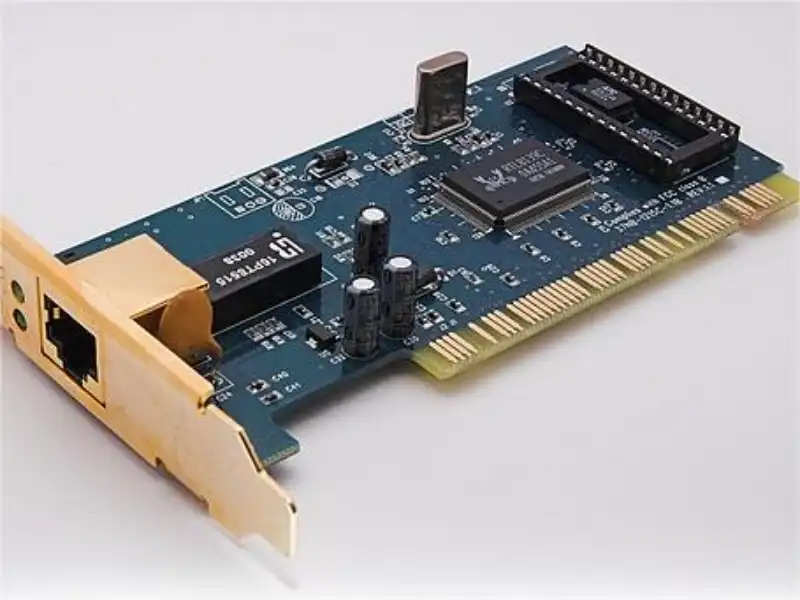- A Network Interface Card (NIC), also known as a network adapter, is essential for enabling a device to connect to a network.
- NICs offer a range of features that can vary depending on the model and manufacturer.
A Network Interface Card (NIC), also known as a network adapter, is a hardware component that allows a computer or other device to connect to a network. It serves as an interface between the device and the network, whether it’s a local area network (LAN) or a larger network like the internet.
Key functions
A NIC, also known as a network adapter, is essential for enabling a device to connect to a network. It provides the physical interface to the network infrastructure through various connectors like Ethernet ports, coaxial connectors, or wireless antennas. The NIC handles data transmission by converting device data into a suitable format for network transmission and dividing it into packets with appropriate headers and trailers. It also receives incoming data packets, decodes them, performs error checking, and passes the data to the device.
Each NIC has a unique Media Access Control (MAC) address to ensure data packets are correctly routed by including source and destination MAC addresses in the headers. NICs support various network protocols such as Ethernet, Wi-Fi, and Bluetooth, ensuring compatibility and proper communication. They influence network speed and performance by supporting specific data transfer rates such as 10, 100,1000 Mbps for Ethernet. Advanced NICs can offload certain tasks from the CPU, such as TCP or IP checksum calculation, TCP segmentation, or encryption, decryption, improving overall system performance. NICs require device drivers to communicate with the operating system for configuration, control, and monitoring. Additionally, some NICs feature power management capabilities to optimise energy usage, entering low-power states when not actively transmitting or receiving data, thus conserving power and extending battery life in mobile devices. A NIC establishes and maintains network connectivity, manages data transmission and reception, assigns MAC addresses, supports network protocols, influences network speed, offloads tasks from the CPU, and optimises power consumption, enabling devices to communicate and access network resources efficiently.
Also read: Quectel presents latest IoT innovations at CommunicAsia 2024
Also read: Unidentified hackers disable 600,000 US routers
Features
NICs offer a range of features that can vary depending on the model and manufacturer.
These features include various connectivity options like Ethernet ports, fiber optic connectors, coaxial connectors, or wireless antennas, enabling devices to connect to different networks. NICs support specific data transfer rates, operate in either half-duplex or full-duplex mode for communication efficiency, and some even have Wake-on-LAN functionality for remote power control. Additionally, NICs may support jumbo frames to enhance network efficiency, offer quality of service features for prioritising critical data, offload tasks from the CPU to improve system performance, and provide security features such as encryption protocols. They often come with management tools for monitoring and controlling network traffic, as well as power management features to optimise energy consumption.
Practical uses
NICs are indispensable components in modern computing and networking, serving various practical purposes. They enable devices like computers, printers, and servers to connect to networks, granting access to shared resources such as files and printers. NICs facilitate data transfer and communication within networks, supporting tasks like file sharing, email, web browsing, and media streaming. They also allow for remote management and access, empowering IT administrators to perform updates and system management tasks without physical presence. NICs with high-speed capabilities enhance network performance, especially for bandwidth-intensive applications like video conferencing, gaming, and large data transfers. In virtualised environments, NICs connect virtual machines to physical networks, enabling the creation and management of virtual networks.
Additionally, NICs provide network security features like encryption and authentication protocols, safeguarding sensitive information. NICs that support Quality of Service (QoS) ensure critical applications receive the necessary bandwidth for smooth operation, while multiple NICs can be utilised for load balancing, optimising resource utilisation and improving service reliability in data centres. Network redundancy is achieved by using multiple NICs in a single device, ensuring uninterrupted service in mission-critical applications. NICs also play a vital role in connecting Internet of Things (IoT) devices to networks, facilitating communication and management. Wireless NICs enable devices to connect to Wi-Fi networks, offering mobility and flexibility, particularly for portable devices like laptops, smartphones, and tablets.

